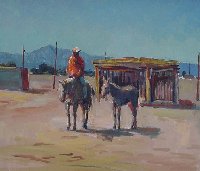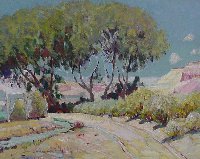| 1888 | Born on January 1 in Osceola, Polk County, Nebraska. |
| 1898 | Visits Trans-Mississippi Exhibition in Omaha. Sees "life-changing" first art exhibit |
| 1903 | Family moves to Germany. |
| 1907 | Passes Entrance Exams Royal Academy of Fine Art, Dusseldorf. |
| 1911 | Wins Academy First Prize - Stained Glass Design. |
| 1914 | Completes 7th year at Dusseldorf Academy. World War I begins. |
| 1915 | Returns to United States. |
| 1916 | First studio in Omaha. |
| 1917 | Builds studio in Saginaw, Michigan on family property of Stuves. |
| 1918 | Joins U.S. Army Camouflage Corps, Chevy Chase, Maryland. |
| 1919 | Discharged from Co. A, 97th Engineers. Occupies second studio in Omaha. |
| 1920 | Paints in New Hope, Pennsylvania with Rogert Spencer. |
| 1921 | Paints in New York with Robert Henri, George Luks, and John Sloan. |
| 1921-1922 | Studies at the Chicago Art Institute where he meets Walter Ufer. |
| 1921-1927 | Annual visits to Taos. Paints with Couse, Ufer, Sharp, Gaspard, and Fechin. |
| 1923 | Nominated to membership in Salmagundi Club, New York by Ufer and Couse. First mentioned in Who's Who in American Art. |
| 1924 | Third studio in Omaha. Visits New York and J. Sloan, E.I. Couse, and G. Bellows. |
| 1925 | Exhibits portraite of "Edith," Pennsylvania Academy in Philadelphia. Voted Nebraska's Outstanding Artist. |
| 1925 | Enters first Group Exhibition at Salmagundi Club; New York, New York. |
| 1925 | First paints in Corpus Christi, Texas. |
| 1926 | Divorce from Augusta Mengedodt |
| 1927 | Midwest Group Exhibition at Kansas City (MO) Art Institute. |
| 1928 | Returns to Omaha; sets up fourth studio. Painting trips to Alaska, Texas, and California. |
| 1928 | San Antonio Group Art Exhibition at the San Antonio (TX) Art Club. |
| 1930 | First painting trip to Arizona. Returns to Alaska and Pacific Northwest. |
| 1930-1939 | Group Exhibition at the Joslyn Art Museum in Omaha, Nebraska. |
| 1931 | California: Paints with Armin Hansen and Christian Vaon Schneidau. |
| 1932 | Marries Lou Ekstrom in Pasadena and paints for three months in California. |
| 1934 | Son Roger is born. |
| 1934 | First visit to Mexico. He headed to Mexico as soon as he heard that the Pan-American Highway had been completed to Mexico City. |
| 1935 | Fifth studio established in Omaha; in the back of his home. |
| 1935-1940 | WPA-Writers Program. |
| 1936-1950 | Exhibits and Jurors Six States Midwest Exhibition. |
| 1937-1970 | Numerous trips to Colorado, New Mexico, Oregon, California, Arizona, and Mexico. |
| 1955-1956 | Spends a year painting in Europe. |
| 1956-1971 | Annual winter trips to Arizona. |
| 1959 & 1962 | Returns to Europe. |
| 1967 | Nebraska Centennial Group Exhibition in Lincoln, Nebraska. |
| 1962 & 1964 | Painting trips to Gloucester, Massachusetts with Emil Gruppe. |
| 1976 | Last entry in Who's Who in American Art. |
| 1977 | Dies in Omaha, Nebraska. Buried in West Lawn Cemetery. |
| 1985 | Listed in publication: Artists of the American West. |
| 1986 | Listed in publication: Mantle Fielding Dictionary. |
| 1990 | Listed in publication: Art Across America (Volume 3). |
| 1994 | Retrospective Solo Exhibition at Museum of Nebraska Art; Kearney, Nebraska. |
| 1995 | Southwest Artists Group Exhibition at the Phippen Museum in Prescott, Arizona. |
| 1999 | Solo Exhibition at Mission San Juan Capistrano, California. |
| 2000 | Exhibition at the Van Vechten-Lineberry Taos Art Museum; Taos, New Mexico. |
 Augustus W. Dunbier was a prolific oil painter and a long time resident (1915 to 1977)
of Omaha, Nebraska, where he became well-established as a portrait painter and private
teacher. He was one of early Nebraska's most successful and influential artists.
Dunbier's career was one of the longest, uninterrupted art careers of any Nebraska painter
and he was an important teacher to his peers and the next generation of Nebraska artists.
One can still see the influences of Augustus Dunbier in the work of many Nebraska painters
today.
Augustus W. Dunbier was a prolific oil painter and a long time resident (1915 to 1977)
of Omaha, Nebraska, where he became well-established as a portrait painter and private
teacher. He was one of early Nebraska's most successful and influential artists.
Dunbier's career was one of the longest, uninterrupted art careers of any Nebraska painter
and he was an important teacher to his peers and the next generation of Nebraska artists.
One can still see the influences of Augustus Dunbier in the work of many Nebraska painters
today.



